- Established 1982 -HOME: www.hiltonpond.org
THIS WEEK at HILTON POND Subscribe for free to our award-winning nature newsletter (Back to Preceding Week; on to Next Week) |
Join us for the |
|
AUTUMN SUNSET, WAYWARD FINCHES,
All text, maps, charts & photos © Hilton Pond Center We were going to write a long note about a spectacular sunset at Hilton Pond Center on 6 November 2018 but decided to let the photo above try to speak a thousand words. A storm had just passed through and dark clouds to the northeast provided a perfect contrast to tall Tulip Trees whose golden-yellow leaves formed glowing spires. Red Oaks still held their leaves in the canopy, while deer-browsed Flowering Dogwoods in the low understory sported foliage of deep scarlet. Ah, autumn! And now on to some bittersweet information about two banded birds from the Center. In the U.S., researchers are authorized by the federal Bird Banding Laboratory (BBL, below right) to catch and band wild birds. Although banding birds is fun, fulfilling, and scientifically productive, the ultimate joy of banding comes whenever the BBL sends out an e-mail entitled "Report to Bander." When one of these comes in, the Master Bander gets understandably excited because it indicates someone has found or recaptured a banded bird elsewhere. Such was the case recently when we got word a bird from Hilton Pond Center had been encountered in far-off Saguenay, just north of Quebec City, Canada (see "Report to Bander," below). All text, maps, charts & photos © Hilton Pond Center CLICK ON REPORT TO OPEN A LARGER VERSION IN A NEW WINDOW The "Report to Bander" uses shorthand codes that are probably unfamiliar to non-banders, so we'll work through the report left to right, starting with Banding Information. Some categories are obvious, including the Band Number and the Banding Date--the latter in this case being 1 April 2017. "Reg" is Region (South Carolina), while Latitude/Longitude pinpoint the banding location. Each bird species gets a four-letter code from the American Ornithologists' Union (Aou); PUFI is short for Purple Finch. Then come the bird's Age and Sex at banding (5 = second year bird that hatched in 2016; 0 = unknown sex at time of banding). The final column under Banding Information is the bird's Status; 300 means it was banded as a normal, free-flying, wild bird. The right half of the report includes the Encounter Information. Our finch was found on 9 June 2018 at Saguenay, 14 months after banding; Quebec's Region is 676, with the corresponding Lat/Long for the capture locale. For this particular Purple Finch, the How Obtained code is 00 (found dead); a Who Reported of 21 means it was reported by the finder (rather than by another bander or a wildlife officer); PC is Present Condition of 05 (band was removed); and Report Method was 07 (via the BBL's Web site at reportband.gov). The finder's name is Eric Wilmot, whose e-mail and address were also on the report. (For privacy's sake we deleted the latter from the image above.)
All text, maps, charts & photos © Hilton Pond Center Since we had Eric Wilmot's e-mail address we decided to contact him directly for more details about our wayward but now dead Purple Finch. Eric responded almost immediately via Facebook Messenger, sending a photo above of the band he removed from the bird. He isn't a bander but as an avid birder knew the importance of reporting a dead banded bird. The most important question we had for Eric was the color of the Purple Finch when he found it. When we banded it last year as a second year bird it was brown--which in Purple Finches means it could have been a female OR an immature male; i.e., male PUFI don't get their full raspberry plumage until after their second summer.
All text, maps, charts & photos © Hilton Pond Center Eric responded to our query with a photo (above) he had taken of the dead finch with band still intact. The bird was indeed red, indicating our Purple Finch was now a third year male. PUFI occur only in winter at Hilton Pond Center, returning to more northerly climes for nesting. Since the finch was encountered in June in Quebec, we suspected he very likely was on his breeding grounds up there; Eric verified such likelihood by mentioning he has observed Purple Finches nesting in the vicinity of the encounter. One further note: Eric told us he found the Purple Finch dead inside a shed at a neighbor's house, and that the neighbor has cats. Evidence is circumstantial but based on the appearance of the bird in the photo above, it does appear to have suffered the kinds of damage that might have been caused by a free-roaming feline. In fact, "Killed by Cat" is one of the more common "How Obtained" categories for dead banded birds reported to the Bird Banding Laboratory. Need we say more?
All text, maps, charts & photos © Hilton Pond Center Thanks a bunch to Eric Wilmot for reporting this long-distance foreign encounter to the BBL, and for providing additional details and photos of our far-flying Purple Finch he found in Saguenay, Quebec (see map above). That's approximately 1,062 straight line miles away from Hilton Pond! All text, maps, charts & photos © Hilton Pond Center
All text, maps, charts & photos © Hilton Pond Center While we're talking about foreign encounters of birds banded at Hilton Pond Center, we should mention we also recently heard about another finch species that showed up elsewhere--although not nearly as far away as our Purple Finch found in Quebec. On 24 May 2018 at the Center we banded a very young brown-plumaged House Finch (HOFI) of unknown sex that couldn't have have fledged more than a few days prior. (See our file photo above of a trio of typical fledgling House Finches begging from their male parent.) Amazingly, this HOFI was found dead only a month later on 21 June by Paula Rieck in Matthews NC, barely across the state line about 30 straight-line miles northeast of Hilton Pond. Although post-breeding dispersal (or, more accurately in this case, post-fledging) is a common behavior among young birds, we find it remarkable so young a finch would travel so far so soon after leaving its nest. It seems more likely a fledgling would hang around its natal site for a longer period, begging from its parents as it grows in strength and learns the ways of the House Finch world. A report like this one brings up almost as many questions as it answers, but every encounter of a banded bird helps us understand avian behavior and ecology just a little bit more. We're grateful Paula Rieck took time to file a report on this wayward young Hilton Pond House Finch via the Bird Banding Lab's Web site at reportband.gov. All text, maps, charts & photos © Hilton Pond Center
All text, maps, charts & photos © Hilton Pond Center In the 1-31 October 2018 installment of "This Week at Hilton Pond," we described an unusual phenomenon that occurred here at the Center: A "Hilton Pondbow." When we looked put at the pond on 5 October we could see a definite rainbow on the surface of the water (photo above), replete with the visible spectrum from red to violet. We speculated an oily sheen from a layer of Rootless Duckweed on the pond caused the pondbow, much like the "rainbow" sometimes seen when oil leaks from a vehicle onto a paved parking lot. At the end of our note we asked for other possible explanations for the pondbow and got an authoritative response from none other than life-long friend Dr. Jim Shuman, who majored in astronomy at Carleton College and just happens to be president of the Board of Trustees for Hilton Pond Center for Piedmont Natural History. Jim included a photo (uncredited, from the Web) and provided this explanation:
It would be hard to discount Jim's scientific details, so we consider his hypothesis as an alternative explanation for the Hilton Pondbow. Thanks, Jim, for your input! Any more thoughts out there? If so, please send them to INFO. All text, maps, charts & photos © Hilton Pond Center
Immature male Ruby-throated Hummingbird (above) with incomplete gorget 6,000 RUBY-THROATS, To celebrate the banding of our 6,000th Ruby-throated Hummingbird (color-marked immature male, above) during the past 35 years of research, Hilton Pond Center is undertaking a fund-raising effort in support of "Operation RubyThroat: The Hummingbird Project." Our goal from now through the end of 2018 is to raise ONE DOLLAR for each of the 6,193 hummers banded locally through since 1984. If you'd like to support our on-going study of hummingbird migration, site fidelity, longevity, and population dynamics here in the U.S. and in Central America, please click on one of the links below to send a tax-deductible donation. (You can also donate through our Facebook fundraising page.) Checks also can be sent to Hilton Pond Center at: All contributions are tax-deductible on your Don't forget to scroll down for Nature Notes & Photos, |
|---|
|
"This Week at Hilton Pond" is written and photographed by Bill Hilton Jr., executive director of Hilton Pond Center for Piedmont Natural History
|
|
|
Please refer "This Week at Hilton Pond" to others by clicking on this button: |
Comments or questions about this week's installment? Send an E-mail to INFO. (Be sure to scroll down for a tally of birds banded/recaptured during the period, plus other nature notes.) |

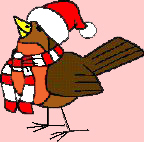
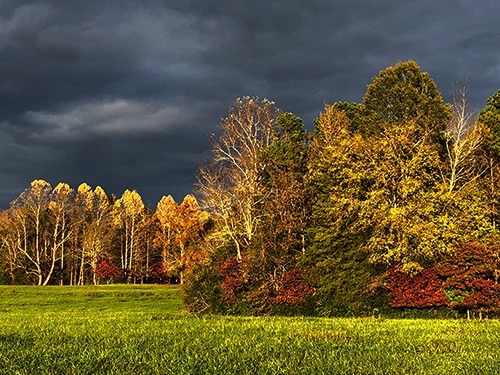
 Master Banders report their activities to the BBL and provide information such as band number, banding date and location, and species and age/sex of each banded bird. Historically, data were submitted on handwritten or typed paper sheets; these days a proprietary computer application appropriately called "Bandit" enables banders to transmit everything electronically.
Master Banders report their activities to the BBL and provide information such as band number, banding date and location, and species and age/sex of each banded bird. Historically, data were submitted on handwritten or typed paper sheets; these days a proprietary computer application appropriately called "Bandit" enables banders to transmit everything electronically. 

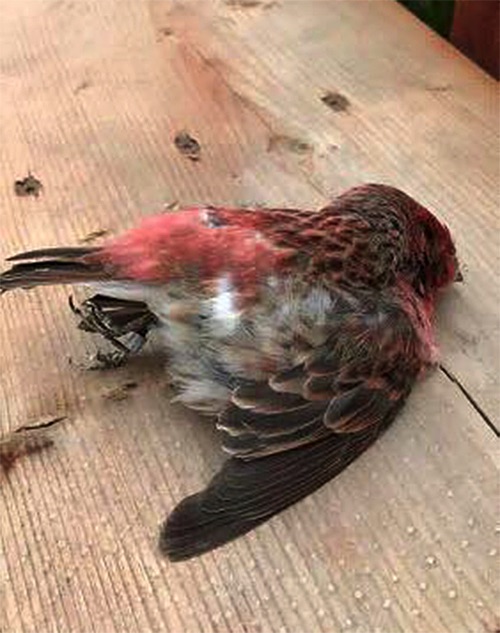
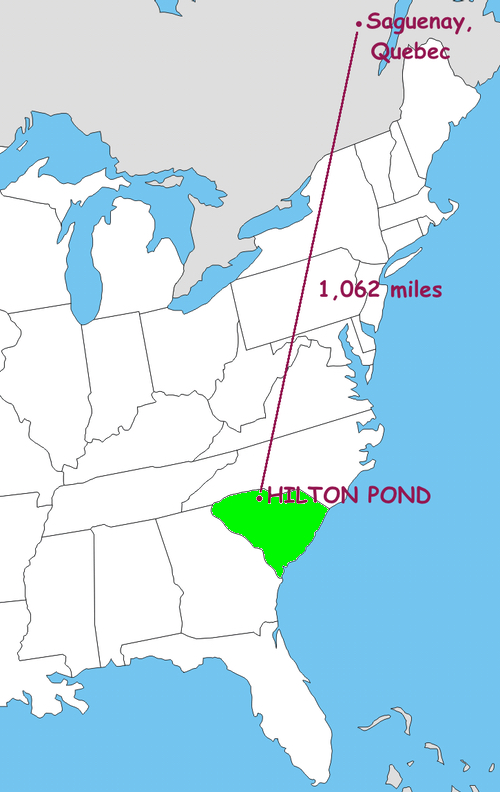
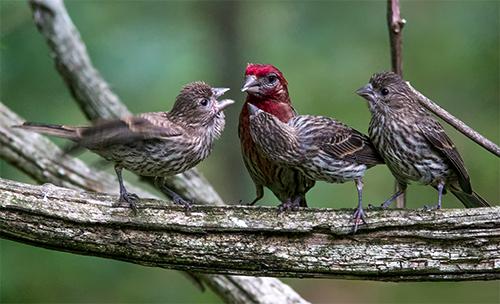
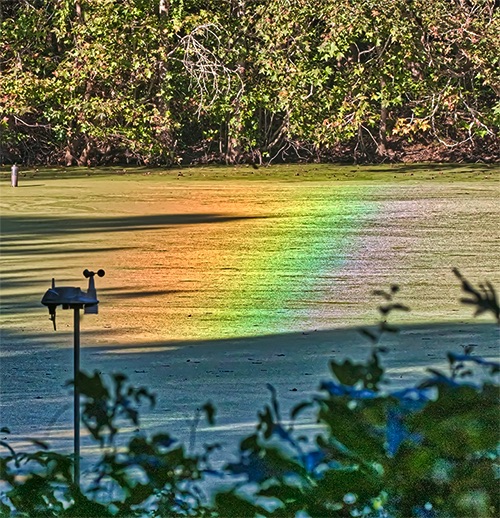
 (i.e., if you were outside), you would most likely have seen a rainbow extending in an arc covering 40 angular degrees from the point opposite the sun. In short, I’ll bet it was raining then, or perhaps foggy; i.e., the atmospheric conditions in the morning were conducive to having water droplets in the air cause a rainbow. The colors of the rainbow produced by those droplets would have shown red on the top (the outside of the rainbow’s arc) and blue/violet on the bottom (inside the rainbow’s arc).
(i.e., if you were outside), you would most likely have seen a rainbow extending in an arc covering 40 angular degrees from the point opposite the sun. In short, I’ll bet it was raining then, or perhaps foggy; i.e., the atmospheric conditions in the morning were conducive to having water droplets in the air cause a rainbow. The colors of the rainbow produced by those droplets would have shown red on the top (the outside of the rainbow’s arc) and blue/violet on the bottom (inside the rainbow’s arc). 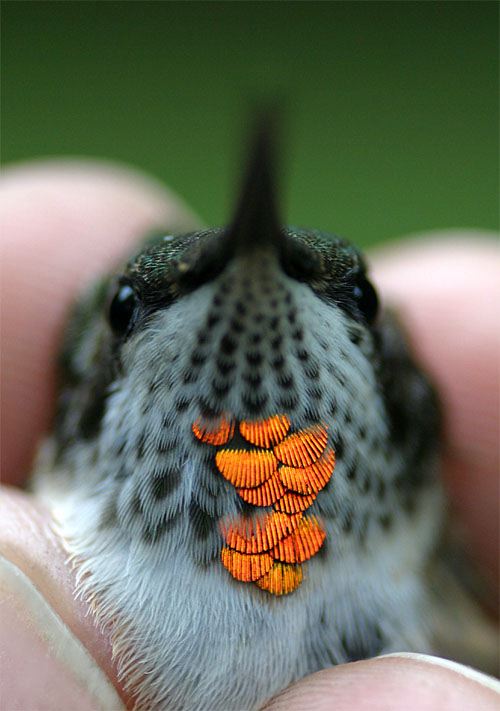









 Please report your
Please report your Oct 15 to Mar 15:
Oct 15 to Mar 15: